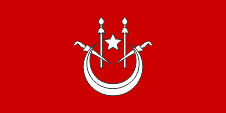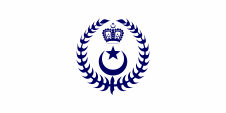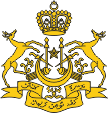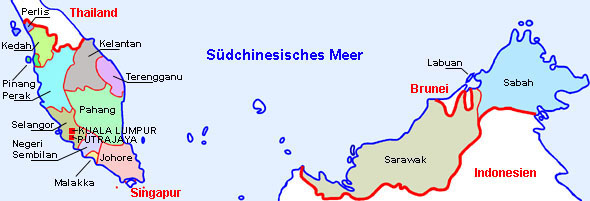Kelantan |
|
|
|
| Übersicht – Contents: | |
Kelantan |
|
|
|
| Übersicht – Contents: | |
Flaggen – Flags: |
|
 |
Nationalflagge – national flag, Seitenverhältnis – ratio = 1:2, Quelle/Source: Die Welt im bunten Flaggenbild |
 |
Standarte des Sultans – standard of the Sultan, Seitenverhältnis – ratio = 1:2, Quelle/Source: Die Welt im bunten Flaggenbild |
historische Flaggen – historical Flags: |
|
 |
1832–1912, Nationalflagge – national flag, Quelle/Source: Die Welt im bunten Flaggenbild |
Bedeutung/Ursprung der Flagge – Meaning/Origin of the Flag: |
|
| Kelantan war (wie Terengganu) ursprünglich ein Teil Siams (Thailand). Als Kelantan sich im Jahre 1832 teilweise von Siam löste, wurde eine einfarbige weiße Flagge verwendet. Diese wurde bis 1912 beibehalten. In diesem Jahr wurde eine neue Flagge eingeführt: Sie war wieder weiß, hatte jedoch einen blauen Rand und zeigte in der Mitte einen aus blauen arabischen Schriftzeichen gebildeten Tiger. Im Jahre 1923 wurde die heutige Flagge eingeführt. Sie zeigt ein einfarbiges rotes Flaggentuch mit einen weißen Halbmond und Stern. Ein deutlicher Hinweis auf die vorherrschende Religion, den Islam. Weiterhin sind Speere und Dolche, ebenfalls in Weiß, zu erkennen. Sie stehen für Stärke und Macht. Das Rot steht für die Treue des Volkes zum Monarchen. geht möglicherweise auf die Flagge von Siam zurück. Die Farbe Weiß ging von der Nationalflagge auf die Flagge des Sultans über, so wie es in den Malaiischen Staaten meist üblich ist. |
Kelantan was (like Terengganu) initially a part of Siam (Thailand). As
Kelantan partially untied itself from Siam in the year 1832, was used a
single-coloured white flag. That was maintained until 1912. In this year was introduced a new flag: It was white again, but had a blue border and showed in the middle a from blue Arabic characters designed tiger. In the year 1923 was introduced
the today's flag. It shows a single-coloured red bunting with a white
half-moon and star. This is a clear hint for the predominant religion, the
Islam. Furthermore are to recognize spears and daggers, as well in white.
They stand for power and might. The red stands for the loyalty of the people to the monarch, and has its roots possibly in the flag of Siam. |
| Quelle/Source: Die Welt im bunten Flaggenbild, Flaggen Enzyklopädie | |
Wappen – Coat of Arms: |
|
 |
Wappen von Kelantan – coat of arms of Kelantan, Quelle/Source, nach/by: Wikipedia (DE) |
Bedeutung/Ursprung des Wappens – Meaning/Origin of the Coat of Arms: |
|
| Das meist einfarbig goldene Wappen von Kelantan ist schon fast eine Allegorie. Es versammelt die schon von der Flagge bekannten zentralen Elemente: Halbmond und Stern (als Symbole der vorherrschenden Religion), sowie Lanzen und Dolche, die um zwei Kanonen, stilisierte Pflanzen und zwei Hirsche als Schildhalter ergänzt wurden. Das Spruchband zeigt das Motto des Landes in arabischen Jawi-Buchstaben: "Berserah kepada Tuhan Kerajaan Kelantan" (Kelantan ist Gott anvertraut). Über dem Wappen die Krone des Sultans. |
The mostly single coloured golden coat of arms of Kelantan is almost an
allegory. It gathers the central elements which are already known from the
flag: crescent and star (as symbols of the dominating religion), as well as lances and krises, which were supplemented by two cannons, stylised plants and two deers as supporters. The banner shows the motto of the country in Arabic Jawi letters: "Berserah kepada Tuhan kerajaan Kelantan" (translation: Kelantan is entrusted to God). Above is placed the crown of the sultan. |
| Quelle/Source: Wikipedia (EN) | |
Landkarte – Map: |
|
Lage auf der Malaiischen Halbinsel – Position on the Malay Peninsula: |
|
|
| Die Bundesstaaten Malaysias – the Federal States of Malaysia: |
| interaktive Landkarte – interactive Map |
 Landkarte/Map: Volker Preuß nach/to Malaysia? => hier klicken – click here |
Zahlen und Fakten – Numbers and Facts: |
|
|
|
|
|
|
|
|
|
|
|
|
|
|
|
|
|
|
|
Geschichte: |
|
7.–12. Jhd. · zum Reich Shrividjaja 14.–15. Jhd. · zum Reich Siam 16. Jhd. · Herausbildung des Sultanats Kelantan unter siamesischer Oberhoheit 1832 · Kelantan kann sich teilweise von Siam lösen 1909 · Anglo-Siamesischer Vertrag, die heutige Grenze zwischen Malaysia und Thailand entsteht, denn Siam tritt Kedah, Kelantan, Perlis und Terengganu an Großbritannien ab und fasst diese Länder 1914 mit Johor zu den "Nichtföderierte Malaienstaaten" zusammen 1941-1943 · von japanischen Truppen besetzt 1943–1945 · Anschluss an Thailand 01.04.1946 · Bildung der Malaiischen Union durch Zusammenschluss der Malaiischen Sultanate (Britische Protektorate) und der Straits Settlements (Britische Kronkolonien), jedoch ohne Singapur 1948 · Reorganisation der Malaiischen Union, Bildung der Malaiischen Föderation unter einem britischen Hochkommissar 31.08.1957 · Unabhängigkeit und Proklamation des Königreiches Malaiische Föderation 16.09.1963 · Proklamation des Königreiches Malaysia |
History: |
|
7th–12th cent. · to the Shrividjaja Empire 14th–15th cent. · to the Siamese Empire 16th cent. · establishment of the Sultanate of Kelantan under Siamese supremacy 1832 · Kelantan separates partially from Siam 1909 · Anglo-Siamese Treaty, the present-day border between Malaysia and Thailand is created, as Siam cedes Kedah, Kelantan, Perlis and Terengganu to United Kingdom and combines these countries in 1914 with Johor to form the "Non-Federated Malay States" 1941-1943 · occupied by Japanese Troops 1943–1945 · annexed to Thailand 1st of April 1946 · creation of the Malaysian Union by confederation of the Malaysian Sultanates (British protectorates) and the Straits Settlements (British crown colonies), however without Singapore 1948 · re-organization of the Malaysian Union, creation of the Malaysian Federation under a British High Commissioner 31st of August 1957 · independence and proclamation of the Kingdom of Malaysian Federation 16th of September 1963 · proclamation of the Kingdom of Malaysia |
| Quelle/Source: 1) Atlas zur Geschichte, 2) World Statesmen, 3) Wikipedia (D) |
Ursprung des Landesnamens – Origin of the Country's Name: |
|
|
Der Ursprung des Landesnamens "Kelantan" und auch seine Bedeutung liegen weitesgehend im Dunklen. Offiziell wird gern gesehen, wenn der Name mit "Land des Blitzes" übersetzt wird. Der Ursprung des Namens kann sein: • das Wort "gelam hutam", der malaiische Name für den Sumpfteebaum (Melaleuca leucadendron) • das Wort "kilatan", malaiisch für "glänzend oder glitzernd" • das Wort "kolam tanah", malaiisch für "Tongrube" • das Wort "Kolaan Thana" oder "Kolaam Thana", eine Bezeichnung aus dem Indischen Raum für "Land von Kolaan" bzw. "Land von Kolaam", wobei mit Kolaan/Kolaam die Bodenmalereien oder Bilder in den zahlreichen alten Hindu-Tempeln gemeint sind. Als das Land zu Siam (Thailand) gehörte wurde es von den Siamesen (Thailändern) "Kalantan" genannt. |
The origin of the country's name "Kelantan" and its meaning are largely unknown. Officially, people like to see the name translated as "land of lightning". The origin of the name may be: • the word "gelam hutam", the Malay name for the swamp tea tree (Melaleuca leucadendron) • the word "kilatan", Malay for "shiny or glittering" • the word "kolam tanah", Malay for "clay pit" • the Word "Kolaan Thana" or "Kolaam Thana", an Indian term for "Land of Kolaan" or "Land of Kolaam", whereby Kolaan/Kolaam means the floor paintings or pictures in the numerous old Hindu temples. When the country belonged to Siam (Thailand) it was called "Kalantan" by the Siamese (Thai people). |
| Quelle/Source: Wikipedia (EN) | |